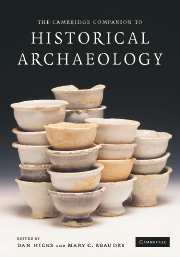Book contents
- Frontmatter
- Dedication
- Contents
- List of figures
- List of tables
- List of contributors
- Acknowledgements
- List of abbreviations
- 1 Introduction: the place of historical archaeology
- PART I ARCHAEOLOGY AND HISTORY
- PART II KEY THEMES IN HISTORICAL ARCHAEOLOGY
- PART III HISTORICAL ARCHAEOLOGY AND MATERIAL CULTURE
- 11 Material culture studies and historical archaeology
- 12 Ceramic studies in historical archaeology
- PART IV HISTORICAL ARCHAEOLOGY AND LANDSCAPES
- PART V HISTORICAL ARCHAEOLOGY AND BUILDINGS
- References
- Index
12 - Ceramic studies in historical archaeology
from PART III - HISTORICAL ARCHAEOLOGY AND MATERIAL CULTURE
Published online by Cambridge University Press: 05 July 2015
- Frontmatter
- Dedication
- Contents
- List of figures
- List of tables
- List of contributors
- Acknowledgements
- List of abbreviations
- 1 Introduction: the place of historical archaeology
- PART I ARCHAEOLOGY AND HISTORY
- PART II KEY THEMES IN HISTORICAL ARCHAEOLOGY
- PART III HISTORICAL ARCHAEOLOGY AND MATERIAL CULTURE
- 11 Material culture studies and historical archaeology
- 12 Ceramic studies in historical archaeology
- PART IV HISTORICAL ARCHAEOLOGY AND LANDSCAPES
- PART V HISTORICAL ARCHAEOLOGY AND BUILDINGS
- References
- Index
Summary
WHY CERAMICS?
Ceramic studies have played a central role in the development of archaeology – a fact that is equally true for historical archaeology as for studies of earlier periods. Ceramics represent by far the largest class of artefacts recovered during excavations of historical sites. As in other periods, ceramic materials survive in the ground when objects made from other materials do not, and their archaeological value is very high even though they generally only survive in a fragmentary state. As ubiquitous products prone to stylistic change in response to new fashions and consumer preference, ceramics are readily datable, and often prove the most important diagnostic materials recovered when an archaeologically excavated sequence is being interpreted. In addition to their value as sensitive temporal markers, ceramics have the potential to provide insights into a wide range of other topics: cultural change and colonisation; the identities of groups and individuals; the social and economic status of consumers; the emergence of changing practices relating to the consumption of food and drink; patterns of trade and of local and regional variations in trade; and technological change and industrialisation.
The past five hundred years have witnessed massive increases in the production, exchange and consumption of ceramics in Asia, Europe, North America and around the world. In Europe, an intensification of international trade in commodities was a central part of nascent colonialism and the transition from medieval to modern societies, as the Old World was opened up to new commodities from the East and as new markets for new commodities developed in the New World and beyond. A chapter on ceramics could be written from many geographical perspectives. The main focus of the present chapter is European-made ceramics, but discussion of non-European ceramics is interwoven throughout.
The development of historical ceramic studies has been primarily a British And North American phenomenon, and the parallel and separate trajectories on either side of the Atlantic are traced in the first section of this paper. The second section provides an overview of ceramic production and technology, primarily told from an archaeological vantage point.
- Type
- Chapter
- Information
- The Cambridge Companion to Historical Archaeology , pp. 205 - 232Publisher: Cambridge University PressPrint publication year: 2006
- 18
- Cited by



